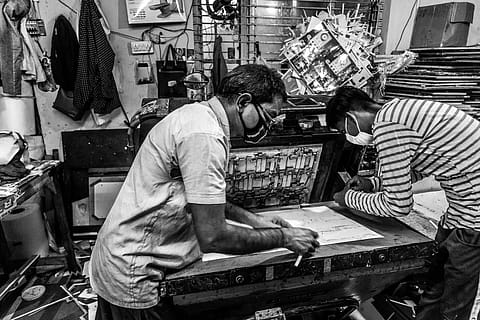Emerging from the shadow of Covid-19
With India's economy unlocking, Fortune India visited a few manufacturing units in Delhi in order to chronicle the changes the pandemic has wrought in the lives of the workers.

The Covid-19-induced lockdown in India had severely hit not only the way we go about our daily lives, but also the way we understand and approach the very notion of work. As many experts have argued, the pandemic has changed the meaning of work, and along with it labour, perhaps, forever. The lockdown, in particular, will be remembered for the huge migrant crisis it led to, with large swathes of workers—bereft of jobs and homes—compelled to make the perilous journey back to their hometowns.
But ever since the government began to unlock the country, a small sense of normalcy seems to have crept in, though nothing is really normal yet. The Coronavirus cases across the country, particularly in Delhi, are surging. Yet, the hubbub of economic life—which had gone completely quiet from mid-March onwards—can be heard. On Friday, November 27, India reported its Q2 gross domestic product (GDP) numbers, and the figures aren't comforting. According to the provisional estimates released by the Ministry of Statistics and Programme implementation (MoSPI), India's GDP has seen a contraction of 7.5%. For the same quarter, the manufacturing sector—one of the worst-hit during the lockdown—witnessed a 0.6% rise in Q2, following an unprecedented contraction of 39.3% in the previous quarter.
In wake of India's economy unlocking, Fortune India visited a few manufacturing units in Delhi in order to chronicle the changes the pandemic has wrought.
A worker in a manufacturing unit in Delhi. Small units, such as these, are known to be cramped spaces, with little to no room for social distancing. As a result, concerns over health hazards loom large.
Ever since the unlock began, India's manufacturing—after suffering a body blow during the lockdown—has seen a remarkable turnaround. But manufacturing units are also home to a large percentage of India's labour. And their lives have only become more precarious.
Experts have repeatedly spoken about the impact of the Covid-19-led lockdown on the labour force. According to the Periodic Labour Force Survey 2017-2018 estimates, a whopping 77.1% of labour in India is non-regular—which means they are either self-employed or casual workers. And the most vulnerable group within this segment are the women. The economic downturn India is undergoing at present is only likely to exacerbate this vulnerable segment further.
Another vulnerable segment in India's labour force are the urban casual workers. This segment—comprising mostly of migrants—were the hardest hit by the lockdown. Being part of an urban unit, the jobs of these workers are also linked with their accommodation as well. Therefore, the lockdown not only killed their livelihood, but it also made them homeless, which was a major contributory factor in the migrant exodus. With India unlocking, some migrants have started coming back.
In manufacturing units, masks have become ubiquitous. While the lockdown had its own challenges, unlocking of the economy has created newer kinds of problems. With the surge in Covid-19 cases, and with many big cities announcing nighttime curfew, the concern now is of infection spreading more. And workers in manufacturing units are especially vulnerable, adding health concern to their already existing economic woes.
Moreover, another factor that also has been overlooked in talking about the impact Covid-19 has had on labour in India is the fact that most of the migrant workers come from socially disenfranchised communities, contributing another layer to their social insecurity.
If anything, this pandemic has only accentuated these socio-economic faultlines more prominently.
(Text: Arnav Das Sharma; Photographs: Narendra Bisht)
(INR CR)